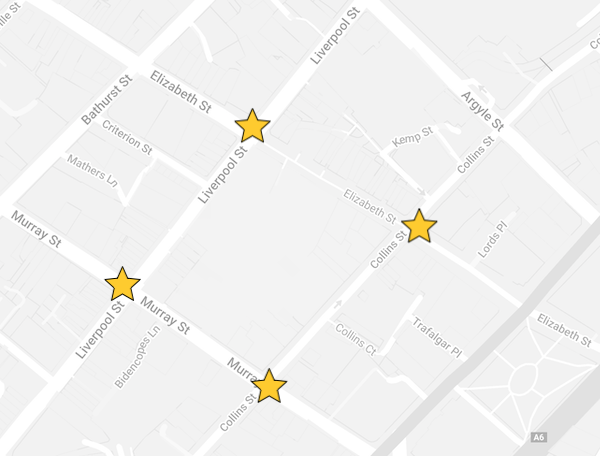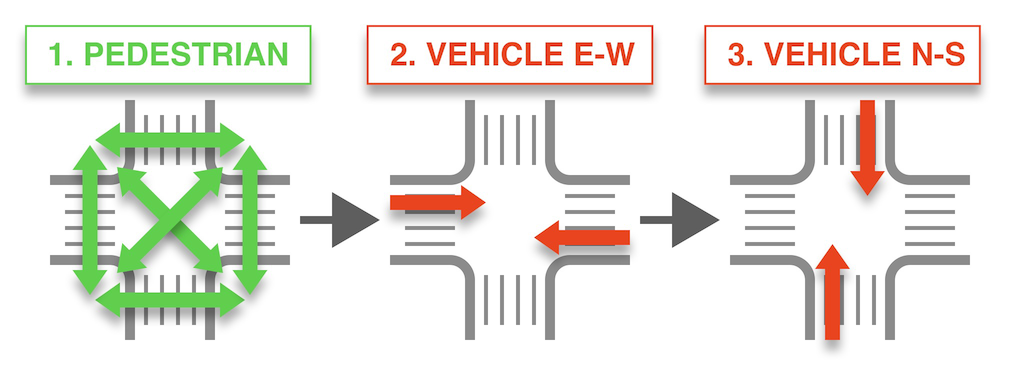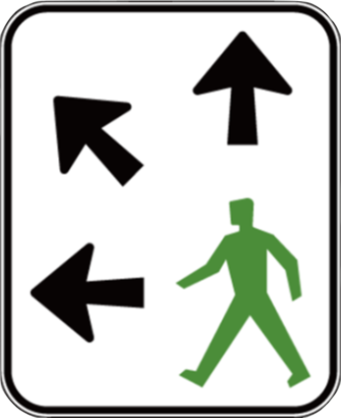What’s the trial?
Since September 2023, City of Hobart and the Tasmanian Department of State Growth — which manages traffic signals statewide — have been trialing scramble crossings at intersections in the Hobart CBD. The trial involves the four intersections of Elizabeth, Liverpool, Murray & Collins Streets.

Scramble crossings involve three traffic signal phases — one is exclusively for pedestrians and enables diagonal crossing:

These crossings are used around the world. Multiple cities in Australia have them — including almost every other capital city — though most of those cities don’t have more than a few.

Why trial scramble crossings?
The council & government haven’t put out much in the way of public communication about the reasons for the scramble crossings trial. However there seems to be three main reasons: pedestrian safety, walkability and traffic management.
1. Pedestrian safety
Having distinct phases for pedestrian & vehicle movement removes the possibility of pedestrians being struck by vehicles — in theory at least.
Two pedestrian deaths in the Hobart CBD in recent years have occurred while the pedestrian was crossing at an intersection with a green light and was struck by a turning vehicle. One was at Argyle & Collins Streets, the other at Macquarie & Campbell Streets. In the Macquarie Street case the coroner specifically recommended “the Department of State Growth urgently review the operation of the traffic and pedestrian crossing lights at the intersection“.
2. Walkability
Scramble crossings may make these intersections more pleasant for pedestrians. That translates to better walkability, which is always a good thing for a city.
3. Traffic management
The third reason for trialling the scramble crossings is that the separate pedestrian phase allows control over how much time is available for vehicle transit. A longer pedestrian phase means shorter vehicle phases, and vice versa. The trial seems to have been deliberately designed to test whether less time for vehicles will influence driver behaviour — in particular whether drivers can be discouraged from using the CBD as a thoroughfare.
Observations of the Hobart scramble crossings
When walking many people feel safer crossing in numbers and without turning vehicles. Some are frustrated at the increased waiting — crossing with the red is reasonably common. Understandably some are perplexed they can’t cross a one way street despite a red light for those vehicles — many cross anyway.
People riding bikes are caught up in the slowed vehicle traffic. Without bike lanes the average rider who is uncomfortable filtering between closely packed vehicles is delayed considerably. One bonus that’s occurred to some cyclists is they can cross during the scramble phase seemingly legally — Tasmanian road rules allow bike riders to cross at pedestrian crossings:
You are allowed to cross at pedestrian crossings but you must stop as near as practical to the crossing. Then you should ride across slowly and safely, giving way to pedestrians.
Tasmanian Road Rule Handbook page 70 — Rules for bicycle riders.
People driving are slowed by the short phases for vehicles — but that’s seemingly part of the plan. It’s unclear without data if there’s been a change in behaviour resulting in less drivers using the CBD as a thoroughfare.
Many drivers have been observed driving through a red light early in the pedestrian phase — some impatiently racing through after the end of their phase, some incorrectly anticipating a change to their phase.
Our thoughts
The good
- It’s excellent to see governments trialling changes specifically aimed at improving Hobart’s walkability.
- Pedestrians might be safer since cars and pedestrians shouldn’t theoretically meet.
- Walkability might have improved overall — pedestrians feel safer walking en masse and separately to vehicles. The exclusive pedestrian phase also reinforces the idea that people have as much right to the street as cars.
- Less people driving through the CBD (rather than to the CBD) would be an improvement.
The less good
- Pedestrians are not necessarily safer since impatient drivers are sometimes speeding through red lights and impatient pedestrians are jaywalking.
- Walkability might not have improved overall — pedestrians are waiting longer overall as evidenced by the flood of people when the pedestrian phase starts. The mall and the one way streets at the intersections exacerbate the inefficiency. Footpaths might also get crowded at busy times. (A qualitative survey of pedestrian experience would be useful.)
- People riding bikes are clearly worse off. This could be mitigated by prioritising the construction of bike lanes on Collins & Liverpool Streets if the scramble crossing are to remain. (Collins is already part of the plan.)
- It’s a measure that can’t realistically be applied to all CBD intersections — Macquarie & Campbell as a pertinent example.
- Some businesses in the CBD say the scramble crossings have negatively impacted their business. This could be true in the short term. In the long term — once behaviour change has occurred and other synergistic changes have been made — it may well be different. Certainly the experience around the world is that the more walkable a city, the better for most types of business.
- Communication about the trials by the governments has been poor. People find change challenging. Not understanding the reasons for a change exacerbates that, as does not being asked for your opinion.
Where it’s up to?
Effectively the trial is ongoing while the report into the trial outcomes undergoes peer review & further consideration.
29 January 2024 — City of Hobart council meeting
Elected members voted against adopting the following recommendations:
- To endorse the implementation of the Inner Hobart Transport Network Operations Plan (TNOP) which underpins the scramble crossings trial.
- That the intersections receive minor capital works to make them scramble crossing compliant — basically kerb changes at some corners. Other potential changes like additional pedestrian signals, changes to painted lines, supporting signage, altered road texture or raising the intersections are not specifically mentioned.
- That an education & awareness campaign be produced for the scramble crossings and also for “informing driver expectations for moving around the Hobart CBD” in light of the TNOP.

Instead elected members voted that:
- “Due to issues with the reported results contained within the report titled ‘Pedestrian Only (Scramble) Phase Trial Outcome and Recommendation’, the report be submitted for peer review to ensure the substantiation of the recommendation is appropriate.“
- “The report be submitted to Risk and Audit Panel and Council for consideration.“
January 2024 — trial analysis complete
Overall conclusion: it didn’t appear “that the trial had any particular impact on the normal operation of the City”.
In particular:
- While travel times increased slightly for some vehicle trips at peak times on Elizabeth Street and Murray Street, this was explained by increasing traffic volumes in the pre-Christmas period.
- Occupation of the council’s off-street car parks grew as expected in the pre-Christmas period.
- Consumer spending in Hobart during the trial period was greater than the same period in 2022.
More info
Agenda & minutes for the council meeting on 29 January 2024
A good overview of scramble crossings (aka ‘Barnes Dance’) as well as alternatives — New York Department of Transportation
Leading Pedestrian Intervals in the NACTO Urban Street Design Guide
Corner Radii in the NACTO Urban Street Design Guide
Discussion of scramble crossing trial at the City of Hobart council meeting 30 October 2023